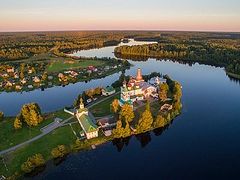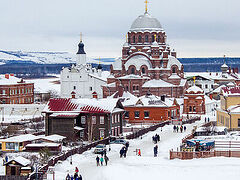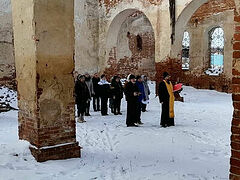Talking with Nadezhda Anatolievna Ignatova, I asked her similar questions over and over again, trying to fathom how she had ventured to restore from ruins the huge Church of the Exaltation of the Cross in the village of Leninsky (the city of Tula), of which only dilapidated brick walls remained?
Before me was a frail, elderly woman. She talked about her work in an everyday way and about miracles that accompany holy labor with joy. But for me the main wonder is her faith in God’s help, which is implemented in deeds before our very eyes. If you happen to see the Church of the Exaltation of the Cross today, you will marvel at how it was possible to undertake its restoration. But if you compare its current state with photos of a year ago, you will understand that the goal will be achieved because a lot has already been done.
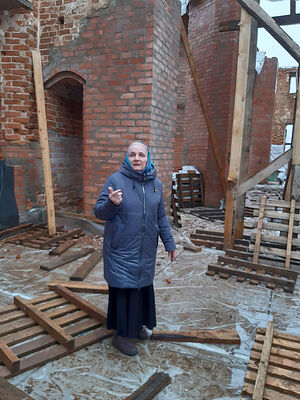 Nadezhda Anatolievna —Nadezhda Anatolievna, why did you decide to tackle the job of restoring a church?
Nadezhda Anatolievna —Nadezhda Anatolievna, why did you decide to tackle the job of restoring a church?
—I don’t know how it happened. I have had cancer for many years now. I underwent six serious operations, four of which were in an oncology unit. Then I suffered relapses, undergoing radiation therapy and many courses of different kinds of chemotherapy. The Lord has led me through the mill. When I developed cancer, I had to quit my job; but I am a restless person by nature and could not sit idle. I learned how to carve wood. I travelled to Tula for church services. Praying for healing, I began to attend services at the Convent of the Kazan Icon of the Mother of God and plunge into the holy spring dug by Blessed Euphrosyne of Kolyupanovo1 near it in the village of Kolyupanovo of the Aleksin district of the Tula region. At that time I suffered from pain, could not kneel or get up from my knees on my own. On Bright Monday, 2009, as I was rereading St. Euphrosyne’s Life, I didn’t notice how I fell asleep and saw in my dream a woman dressed as a nun; and, looking down, I saw my legs below my knees. I started making movements, as if washing them with water, but there was no water. Then I woke up. It seemed that I had slept for fifteen minutes, but it turned out that I had slept from four in the afternoon to eight in the evening. I turned on my side—and there was no pain! I sat up— again there was no pain! I recalled my dream! I rose a healthy woman! Since then I have been able to move normally and live without painkillers. The Lord had such mercy on me! After that I received a blessing from the abbess of the convent in Kolyupanovo to work at the convent and began to travel there and help them. When I asked for an obedience, I believed that there would be a peaceful life there in nature, prayers and grace. But I was absolutely wrong! We would get up at five in the morning and go to bed at half past two in the morning. I would carry bags twenty-five kilograms each. Can you imagine that, after all my operations? The Lord gave me strength!
—And then the Lord drew your attention to the old ruined church in your village. How did it come to pass?
—I can’t answer that question.… Perhaps God’s help in my recovery influenced this decision. The Church of the Exaltation of the Cross stands on an elevation, and its walls can be seen from the windows of our house. And it just occurred to me to study the history of this church and the village. We have two very old churches in the village: one in honor of the Exaltation of the Cross, which was built in 1808, and another in honor of St. Alexander Nevsky, founded in 1866. They are about fifty yards from each other. I started going to archives and libraries, collecting materials about them. As a result, I wrote a three-volume book, to which I devoted fifteen years of my life. At a meeting of the Board for Research and Theological Review and Expert Evaluation of the Publishing Council of the Moscow Patriarchate, all three volumes were approved for publication. The book is waiting in the wings, as there are difficulties with funding. Having learned the history of the parish since ancient times, I couldn’t help but begin restoring the house of God.
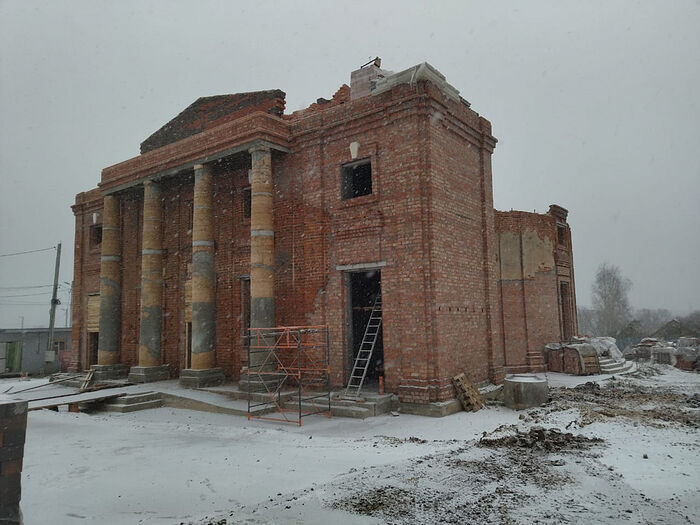 Church of the Exaltation of the Cross in the village of Leninsky
Church of the Exaltation of the Cross in the village of Leninsky
—How could such a thing occur to you? It’s a huge ruined church…
—It didn’t seem so huge. Trees and shrubs grew around, inside and on the church itself. Only when we cut them down and cleared the area inside and outside did the church open up before us in all its glory, although its walls were in a ruinous state and there were large holes in them. When we held a prayer service for the beginning of the restoration work on August 17, 2014, I told people about the church—its history, how beautiful it used to be, what unusual architecture it had, and who were the people who used to live here.
—Perhaps even clearing such an enormous church from debris was a very big task!
—That is a separate story, about how we took out the soil and bailed out the water from the family crypt of the church builders, passing buckets to one another from a great depth; how we entered the church area and had no idea where we should start clearing, because the layer of construction and household debris was two to three meters deep. We started from the top! But how much joy we had when we finally found the floor with the old stone tiles! All this was done by hand, with the help of shovels, buckets and construction carts for the glory of God!
—When the work on clearing the church commenced, did you notice God’s help?
—We did. At the very beginning of the work on clearing the area we found a large cross from one of the domes. It had been lying at the very entrance to the church from the north gate. How many scrap metal collectors had walked here with metal detectors before—and no one had detected it! And then it was found “accidentally”! It was on our wedding anniversary with my husband—August 15, 2014. God sent us such a present! We had completely forgotten what date it was and only realized it the next day. Miracles began to occur from this cross. Families who had been childless for eight or nine years finally became parents. The first boys who were born after prayers in front of this cross are now seven years old. These stories were covered in a local newspaper and in the Orthodox Blagovest newspaper in Samara. After these publications, new people began to come and help restore the church—some with their own labor, others with money or building materials. A couple came—the husband is a Muscovite, and the wife is local. They had no children, but now they have two—Peter and Paul. Through the prayers in our church over a dozen children have already been born! And the grace of God is still here.
—You have plenty of miracles!
—When I started to draw up documents for the church, I was told to prepare 25,000 to 30,000 rubles. About an hour later I had a phone call: An unknown woman (from Krasnodar or the Stavropol Territory) said, “Nadezhda, I want to donate 25,000 or 30,000 rubles to your church.” I asked her, “How did you learn about us?” She answered, “I came across a newspaper that wrote about you.” I said, “The Lord Himself gave it to you.” Here is another story. The Archangel Michael Orthodox Fund raised the funds for a nickel-plated holy water bowl, a Gospel, and other church items. But when the manufacturer issued the invoice, it turned out that only a gilded holy water bowl was available, and it costed 21,000 rubles more. I was about to pay the difference from my own pocket. But the seller forgot to issue an invoice. When he did it the next day, it turned out that a discount had gone into effect, and I had to pay only extra 7,000 rubles! Wasn’t it the mercy of God? Who, if not the Lord Himself, knows that the church is being restored with donations, that we are collecting funds for utensils throughout the country? Glory to God for everything!
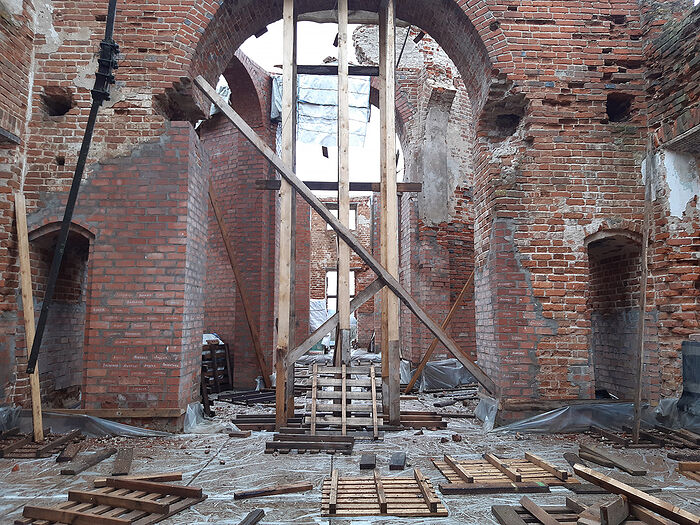 Even in the current state it can be seen that the church has a majestic and complex architecture
Even in the current state it can be seen that the church has a majestic and complex architecture
—Did the diocesan administration willingly bless the restoration of the church?
—My initiative surprised everyone, to put it mildly. As far as I know, even now all churches in the diocese are restored by clergy, but here a woman comes up with the idea. And most importantly, our church was in a very ruinous state. In our village even a small, new, single-altar church was built, because they did not bless the restoration of the old churches. I made two attempts to receive the blessing. In 2012, I was supported verbally, but after a while I received a written refusal. I realized that it was God’s will when my metastases were detected soon. But in January 2014, after another operation and the last course of chemotherapy, I was already in the office of the Minister of Culture of the Tula region. I asked them to send a commission that would determine whether it was possible to restore our churches or not. Having received their inference that they could be restored, and having secured a letter from the head of the district administration, I had appointment with Vladyka Alexei, Metropolitan of Tula and Efremov, who blessed me to become the chairperson of the parish council.
—Did the illnesses stop bothering you after you had undertaken the church restoration?
—In 2017, I underwent abdominal surgery at an oncology unit. During the operation I saw that I was at the Divine Liturgy, at which angels were singing. My brain didn’t shut down from anesthesia, and I prayed. The results of the histology were miraculous! The tumor had begun to turn into a malignant one, but it was stopped by the grace of God. I was already busy with the church and needed to fence off its territory. I didn’t tell any of the parishioners about the operation. I was supposed to stay in bed, but I was on the go, and as a result I developed hernias, both umbilical and inguinal. They started to ache, and doctors suggested surgery. A thought flashed through my mind: “Tomorrow I will confess, take Communion, and everything will pass.” During the Liturgy I suddenly had pangs in my navel area… I prayed: “Oh my God, stitch it up! Stitch it up without anesthesia—I’ll endure it!” In the evening I asked the Lord to forgive my lack of faith; the pain disappeared. I went for an ultrasound, but I no longer had hernias. So, since 2017 I have been continually with a shovel, a bucket, and immersed in work.

